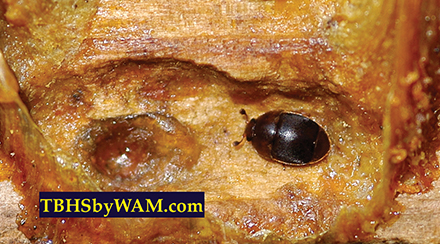
Last month, we learned how summer could bring a surge of varroa mites immigrating into hives. The number of varroa mites entering a hive on its returning robber bees could accumulate to large numbers, preventing the colony from producing its long-lived bees needed for winter survival.
Summer also brings another “pest” infiltrating hive defenses – small hive beetles (see Figures 1 and 2). In some seasons small hive beetle immigration can increase drastically. For example, last summer in Piedmont Virginia, adult small hive beetles invaded hives in large numbers. With only the adults, no larvae, small hive beetles evicted strong colonies from their combs. The bees clustered on the fronts of the hives. Eventually the bees flew away, leaving the hive contents for beetle reproduction. Apparently, the beekeeping management defense of keeping colonies strong and covering their combs did not work when adult beetles invaded in large numbers during the summer.
In a more typical scenario, small hive beetles destroy weak colonies in the summer. These colonies have become weak from some other problems, and the beetles exploit the situations to produce potentially thousands of beetles. Neighboring beekeepers would “see” these beetles as the ones immigrating into their hives. I do not keep weak colonies, trying to nurse them along, like I did many years ago because of their vulnerability to beetles.
Those weak colonies could be found in managed hives not adequately cared for, or hives a beekeeper did not know were in distress. Quite often the hive appears normal from the outside. There are plenty of bees at the entrance. Maybe the colony in question has reduced flight, but it is similar to other colonies in the apiary during a summer dearth. Inside the hive, there could be thousands more beetle larvae than bees with combs engulfed in slime preventing honey robbing. Bees at the entrance can be misleading. Inspect the hive to be sure of the colony’s condition.
The weak colonies could be feral ones that inevitably perish from numerous problems. Feral colonies are easy to “blame,” even if one never sees a mature small hive beetle larva crawling from a knothole entrance of a tree (to pupate in the soil). I once saw a split-open bee tree full of small hive beetle larvae. As a witness, I know feral colonies can produce a large number of beetle larvae. Most likely that translates to elevated immigration rates for nearby managed colonies. So consider feral colonies a source of small hive beetles. Just like many decades ago, most beekeepers regarded feral colonies as a source of American Foulbrood. (Probably in both cases managed colonies back then and today were the far greater source of beetles and bacteria.)
Besides small hive beetles immigrating into a weak colony, killing it in the summer, there is another scenario. The beetles could immigrate into a moderate to strong colony and perhaps be a factor in its death during the winter. As is usual, experience from the bees motivates the investigation.
I had new colonies that survived the summer and fall of 2017, heavily loaded with small hive beetles. In late winter, the colonies ….


